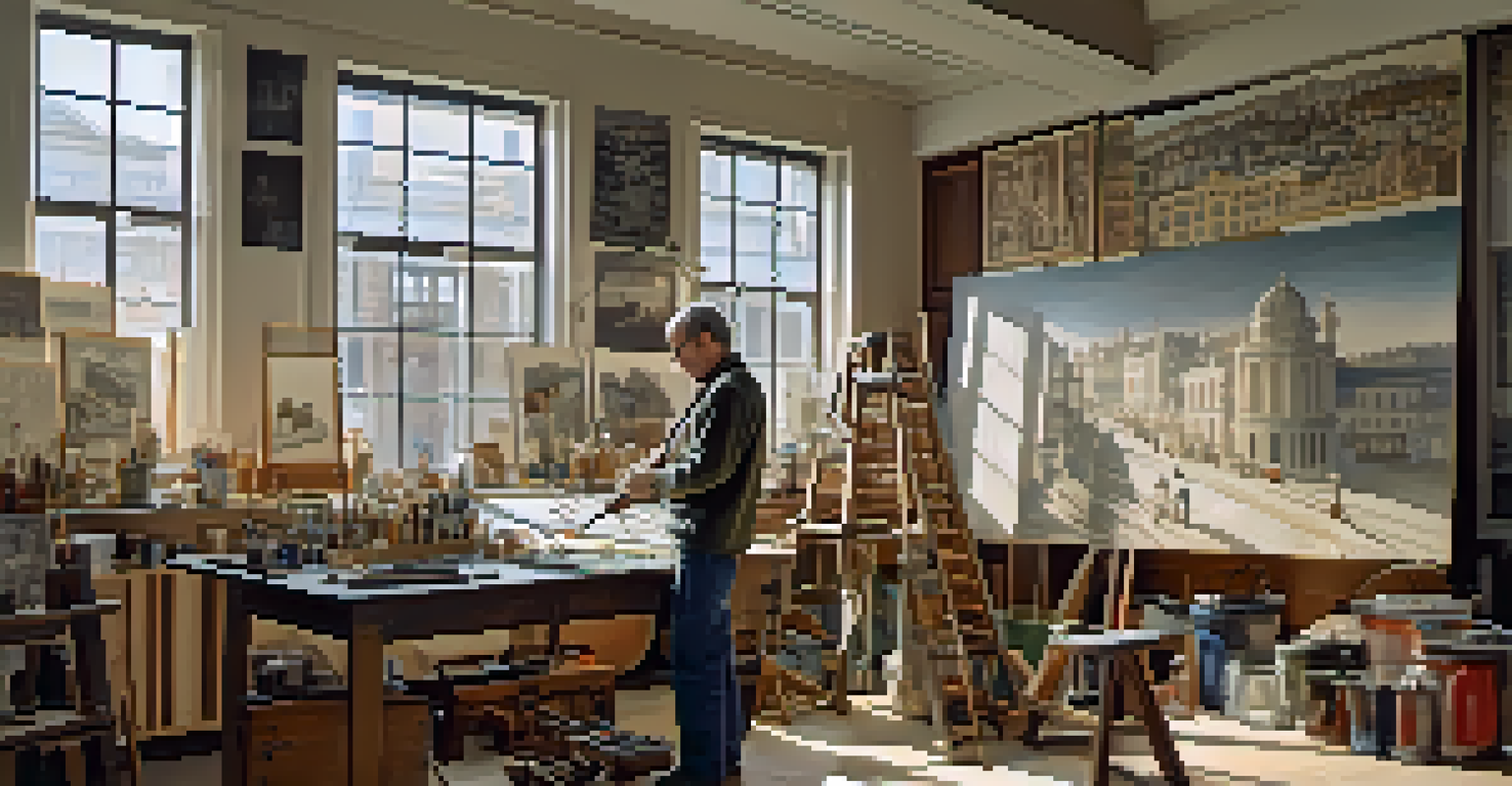Constructivism: Art as a Tool for Social Change in Russia

Understanding Constructivism: Origins and Principles
Constructivism emerged in Russia after the 1917 Revolution, reflecting the country's desire for social change. It rejected traditional art forms, embracing a new aesthetic that prioritized functionality and social purpose. Artists like Vladimir Tatlin and Aleksandr Rodchenko championed this movement, believing that art should serve the collective rather than individual expression.
Art is not a mirror held up to reality but a hammer with which to shape it.
The principles of Constructivism emphasized utility, abstraction, and the integration of art with life. Artists sought to break away from bourgeois conventions, creating works that were accessible and relatable to the masses. This shift was not just about aesthetics; it was a profound ideological stance aimed at reshaping society.
By fostering a sense of community and shared purpose, Constructivism played a crucial role in the cultural landscape of post-revolutionary Russia. It inspired a wave of creativity that aligned with the new socialist ideals, showcasing how art could rally people towards a common goal.
Art as a Tool for Social Change: Key Examples
Constructivist artists utilized various media, from painting to architecture, to promote social messages. One of the most iconic examples is Tatlin's 'Monument to the Third International,' a towering structure designed to symbolize the revolutionary spirit. Although it was never built, its concept represented the aspirations of a new society and the potential of art as a transformative force.

Another significant example is Rodchenko's graphic design work, which combined bold typography and striking imagery to communicate political messages. His posters played a vital role in disseminating revolutionary ideas, making complex concepts more digestible for the general populace. This approach illustrated how art could transcend traditional boundaries and engage with everyday life.
Art as a Catalyst for Change
Constructivism demonstrated how art could serve as a powerful tool for social transformation, inspiring collective action and new societal ideals.
These examples underscore the belief that art could ignite social change, inspiring citizens to participate in the new societal framework. Constructivism demonstrated that creative expression could have a tangible impact on public consciousness, making it a powerful ally in the quest for social transformation.
The Role of Artists in the Constructivist Movement
Artists were not just creators but also activists within the Constructivist movement. They collaborated with architects, designers, and engineers, blurring the lines between art and practical application. This interdisciplinary approach allowed them to tackle social issues from multiple angles, reinforcing the belief that art should be functional.
The artist is not a special kind of person; rather, each person is a special kind of artist.
Key figures like El Lissitzky and Varvara Stepanova played pivotal roles in this collaborative spirit. They designed revolutionary propaganda, clothing, and even furniture that reflected the ideals of efficiency and modernity. Their work exemplified the integration of art into everyday life, pushing boundaries and challenging the status quo.
This collective effort showcased the importance of collaboration in achieving social change. By uniting their talents, these artists amplified their impact, showing that art could serve as a unifying force in a rapidly changing society.
Constructivism's Influence on Soviet Society
The influence of Constructivism extended beyond individual artworks; it permeated Soviet society at large. The movement inspired new educational systems, where art was used as a tool for teaching and community building. Schools incorporated Constructivist ideals, allowing students to engage with art in meaningful ways, fostering creativity and critical thinking.
In architecture, Constructivist principles led to the design of functional public spaces that reflected the values of the time. Buildings were stripped of ornamentation, focusing instead on geometric forms that emphasized utility and collective use. This shift not only transformed the physical landscape but also altered the way people interacted with their environment.
Collaboration Redefined Art
Artists within the Constructivist movement blurred the lines between art and practical application, emphasizing the importance of interdisciplinary collaboration in addressing social issues.
By embedding these ideals into the fabric of society, Constructivism helped shape a new cultural identity in the Soviet Union. It illustrated how art could influence social structures and encourage citizens to envision a better, more equitable future.
Challenges and Critiques of Constructivism
Despite its revolutionary ideals, Constructivism faced significant challenges and critiques. As the Soviet regime solidified its power, artistic expression was increasingly constrained by ideological demands. Many Constructivist artists found themselves at odds with state expectations, which often prioritized propaganda over genuine artistic exploration.
Critics argued that the movement's focus on utility sometimes overshadowed the emotional and aesthetic aspects of art. While the intention was to connect with the masses, some believed that this approach reduced art to mere function, stripping it of its capacity to inspire and provoke thought. This tension revealed the complexities of balancing art with social responsibility.
These challenges highlighted the precarious nature of artistic freedom within a politically charged environment. Though Constructivism sought to empower artists and communities, the realities of censorship and control often stifled its potential, prompting debates about the role of art in society.
Legacy of Constructivism in Contemporary Art
The legacy of Constructivism continues to resonate in contemporary art, influencing movements worldwide. Its emphasis on social engagement and functionality can be seen in various art practices today, where artists strive to address pressing social issues. The idea that art can be a tool for activism remains a powerful concept that resonates with many.
Modern artists often draw inspiration from Constructivist principles, experimenting with materials and forms to create works that engage with their audiences. This ongoing dialogue reflects a commitment to using art as a means of communication and social commentary, just as the Constructivists envisioned.
Legacy of Social Engagement
The principles of Constructivism continue to influence contemporary art practices, encouraging artists to engage with pressing social issues and fostering dialogue through creativity.
As we navigate present-day challenges, the lessons learned from Constructivism remind us of art's potential to foster change and inspire action. By embracing this legacy, contemporary artists continue to explore how creativity can contribute to societal transformation.
Conclusion: The Enduring Power of Art for Social Change
Constructivism serves as a compelling example of how art can drive social change, highlighting the transformative power of creativity. Through its innovative approaches and commitment to functionality, this movement reshaped the relationship between art and society in Russia. It demonstrated that art is not just a reflection of culture but a catalyst for progress.
As we reflect on the impact of Constructivism, we are reminded of the importance of fostering creativity that engages with social issues. Art has the ability to challenge norms, inspire dialogue, and unite communities in pursuit of a common goal. This enduring legacy encourages us to think critically about the role of art in our lives and its potential to effect change.

In a world where social challenges persist, the principles of Constructivism remain relevant. By embracing the idea that art can serve as a tool for social transformation, we can continue to explore new avenues for creativity that resonate with today's societal needs.